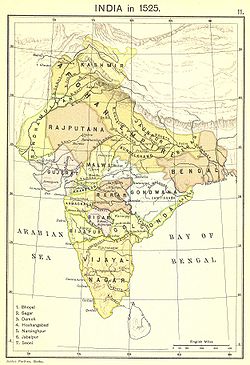
Back গোণ্ডোয়ানা Bengali/Bangla Gondwana (país) Catalan Gondwana (Indien) German Gondwana (India) Spanish Gondwâna French ഗോണ്ട്വാന (ഇന്ത്യ) Malayalam Gondwana (India) Dutch Gondwana (India) NB Gondwana (Indien) Swedish கோண்டுவானா (இந்தியா) Tamil
This article needs additional citations for verification. (December 2024) |
Gondwana | |
|---|---|
 Gondwana kingdom 1525, as depicted in central India, on a map drawn in 1907 | |
| Coordinates: 21°N 81°E / 21°N 81°E | |
| Country | India |
| Region | Central India |
| Proposed capital | Nagpur |
| Proposed Divisions | List
|
| Language | Gondi |
Gondwana, also known as Gondaranya, the land of Gondwana, is a region of India named after the Gondi people. The supercontinent, Gondwanaland, was named after the Gondwana region, because it contained some ancient fossil-bearing rock formations.[1]
Since Gondi people are spread widely across central India, the region has no unambiguous boundary. However, the core region can be considered to be the eastern part of the Vidarbha region of Maharashtra, Garha Kingdom the parts of Madhya Pradesh immediately to the north of it, and parts of the west of Chhattisgarh. The wider region extends into parts of northern Telangana, Andhra Pradesh, western Odisha and southern Uttar Pradesh.
The region is part of the northern Deccan plateau, with an average height of about 600–700 metres. Geologically, it is mostly Precambrian rock, with some areas of Permian and Triassic age. In places, these older rocks are overlain with alluvium, while in the west, it is overlain by the igneous rocks of the Deccan Traps. The landscape is generally rugged and hilly.
The climate is hot and semi-arid. Large sections are forest, specifically dry monsoon forest and monsoon scrub forest. Gondwana contains several national parks with tiger populations.
Gondwana has a relatively high proportion of people from the "scheduled tribes" of India, including the Gonds. The scheduled tribes are recognised as economically and socially disadvantaged. Gonds are followers of religion based on Gondi.[2]
- ^ Chakrabarti, Pratik (2019). "Gondwana and the Politics of Deep Past". Past & Present. 242: 119–153.
- ^ Mehta, Behram H. (1984). "Gonds of the Central Indian Highlands".